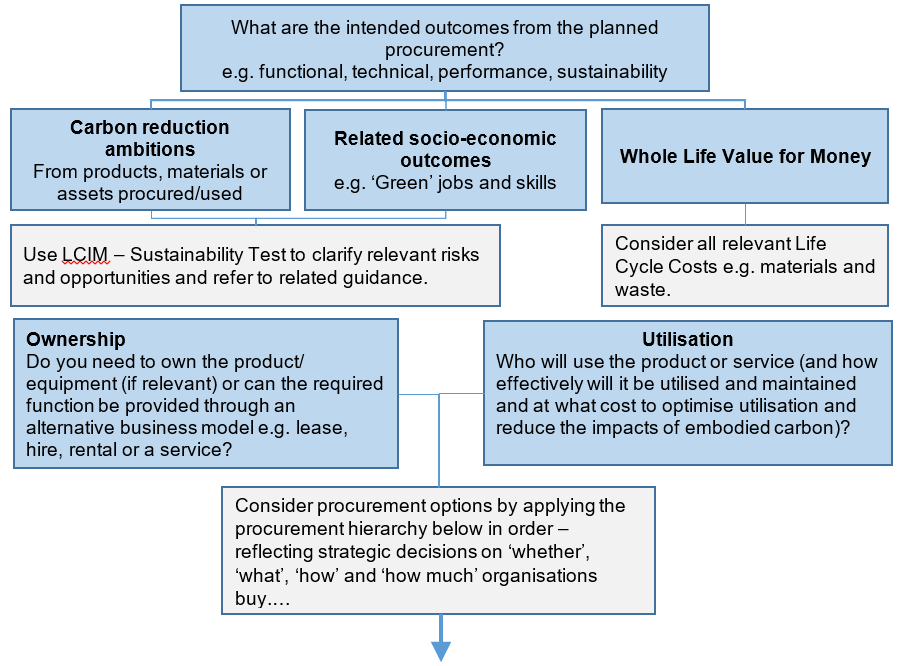As the Procurement Journey emphasises the most positive outcomes, including those relating to embodied carbon, will arise from early consideration, involving key stakeholders, of intended outcomes and the optimum solution(s).

Note : Life cycle impact mapping (LCIM)
1. Do you really need to buy?
Can you reduce embodied carbon by reducing the amount procured?
Can you satisfy need and reduce embodied carbon by making optimum use of existing products, materials or assets already owned, by refurbishing/ reusing products, materials or assets from elsewhere? See an example from Kelvin College on the practical application of this hierarchy approach and the environmental and financial outcomes this delivered here.
2. Can you meet the need in a lower carbon way?
Innovative or disruptive technologies can radically change the way a need is met.
Can the need be future proofed including delivery through an alternative business model e.g. ‘product as a service’ where the supplier retains ownership and where there is an incentive for the supplier to ensure products/ materials are durable, so potentially reducing embodied carbon impacts?
3. If you need to buy
Focus on embodied carbon emissions of product or services at the procurement stage. Reducing the total amount of materials and virgin inputs and therefore embodied carbon within products or services includes consideration of:
Sourcing – where does the product or material (including used within services) come from, who made it, how is it designed, what is it made of?
Utilisation – how will it be used, can you reuse internally or externally, can you repair or refurbish?
End of life – maximising reusability or recyclability of products/ materials; what happens to it at the ‘end of life’?
Consideration of these life-cycle impacts can help to identify reductions in the life cycle costs of ownership for the end user as well as carbon – realised financial savings can help to justify the investment of resource or higher upfront costs, where relevant.
This may be applied through relevant standards and/or outcome-based requirements.
Mature dialogue - allow sufficient time for mature dialogue with the market early to set out your embodied carbon objectives and determine the nature of the potential market. This signals your intent to the market (as well as internal stakeholders), and to provide a basis for measuring and managing overall performance - including through the use of Prior Information Notices (PIN)/ Request for Information (RFI)/ Market events.
For example, the use of reclaimed materials for construction projects is potentially an important mechanism to reduce embodied carbon impacts – others may exist and a market intelligence gathering exercise should be undertaken before any procurement is started:
Innovation - this includes opportunities for innovative embodied carbon solutions (for example, new products, materials or processes). Cross functional working is essential to encourage and enable opportunities for innovation, involving all those who influence intended procurement budgets and outcomes. For example, are policy and mechanisms in place to consider alternatives to ‘the norm’; is the finance function in the public body supportive of innovative approaches? Do they allow / encourage ‘invest to save’ and similar?
Capability - how capable is the market in delivering these ambitions? The maturity of the market regarding embodied carbon reduction can vary across categories e.g. major ICT and construction suppliers can be relatively mature in their approach while other organisations and sectors may be less mature.
It should be remembered that the majority of products supplied involve packaging of some sort, so a focus on reducing embodied carbon should also consider packaging life-cycle impacts.
Return to Legal and Policy Context – Climate Change Obligations
Continue to Procurement Guidance